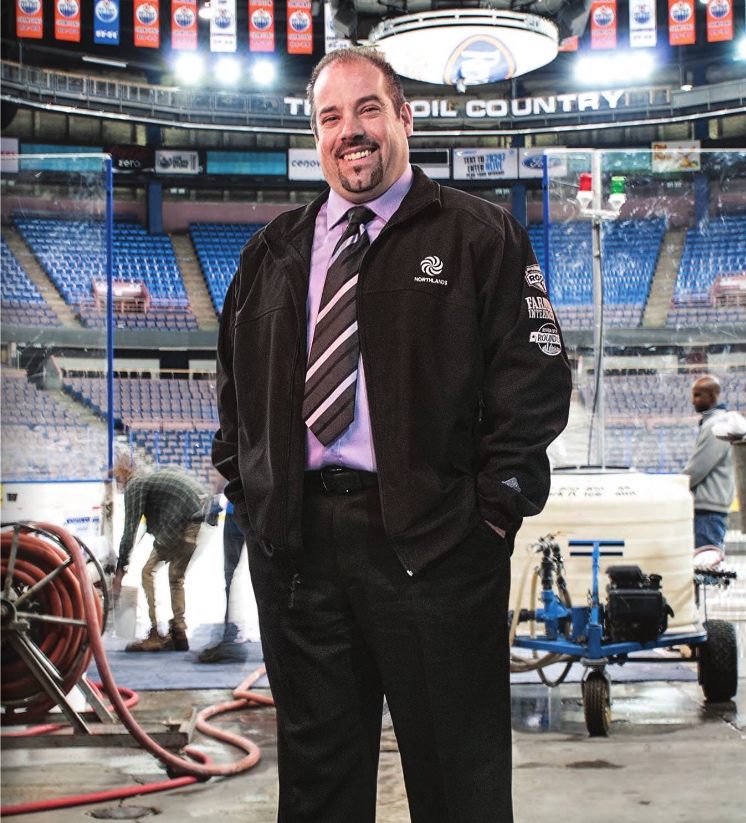Who: George Waselenchuk
Age: 43
Job: Operations Manager, Rexall Place
Experience: George Waselenchuk has been with Northlands since the Oilers had the likes of Gretzky, Kurri and Messier on the ice. He got his first job with Northlands when he was 15 years old. “I worked my way up through the organization,” says Waselenchuk.
Over the years, Waselenchuk made ice and even drove the Zamboni between periods at Oilers’ games. He also took some arena operations courses from the Alberta Association of Recreational Facility Personnel so he’d have the credentials to help him move up the ladder. Now, Waselenchuk is in charge of making sure the operations at Rexall Place run smoothly.
According to concert-industry site, Pollstar, Rexall Place is the 26th-busiest arena in the world, not counting hockey games. Add Oilers and Oil Kings home games and you’ve got almost another 100 dates on the schedule.
For concerts, decking is put down on the ice to protect it. After a concert, the ice is expected to be ready within eight hours. But the ice is melted and hauled away in barrels for the summer, as well as for longer events like the Canadian Finals Rodeo. It takes 36 hours to completely build the ice surface from scratch.
- “What we do is make sure the floor is clean. We have to make sure there are no foreign materials, no oils, no paint. Even things like grease, like vegetable oil and food materials, will cause problems. Food dyes don’t freeze very well, so things come up through the paint. You have to start with a clean floor, then put a thin layer of ice down. Once the thin layer of ice is down smooth, then we paint it white, then we put some more ice on top of that, and then we put down our lines and logos.
- “When you see ice in nature, like on a lake, it’s essentially white because there’s imperfections in it. Here [we paint it white] for television, mostly. In the ’50s, they didn’t paint it white. If you didn’t paint it white it would look like concrete, so it needs to be white so you can better see the puck and give a better look for advertisers. You see the lines better – and it just looks better all around.
- “The standard [thickness] for NHL ice is about an inch and a quarter. And ours varies; there are waves in the floor from heating and cooling over the years. It’s not perfectly level. We do our best to maintain certain industry standards.
- “The NHL standard for ice surface temperature is about -6 [degrees Celsius] … We want the building to stay under 20 degrees [Celsius] . It can also be too cold. But, definitely too warm is tougher to deal with than too cold. In NHL standards, the information that they send out to us is that they don’t want us to be above that 20-degree mark.
- “Outdoor temperature does make a difference to a degree. But you can engineer [the air] for an arena nowadays. It’s not as bad as it used to be. It’s definitely more challenging in the summer when you go deep into the playoffs. This building was definitely built and engineered for winter hockey. So, in the fall, it’s more challenging because there’s more humidity in the building. Humidity is tough to deal with. We combat that by tempering the building air, trying to recycle some of the air to get rid of some of the moisture. Some of the newer buildings in the NHL have dehumidifiers; we don’t have that. Some have humidifiers. We also do not have that. But there are ways we can work around that to modify the temperature of the air.
- “After a hockey game, we shave the skate grooves out of it, flood it with water to make it as smooth as possible. For concerts, we cover it with ice decking, which, over the years, has evolved quite a bit. When I first started here, it was an insulated material called Homasote, now it’s fibreglass and polystyrene material – it’s recyclable material. They cover the ice with this decking material and then as soon as it comes off after a concert, there’s cracks in it … pop and beer gets spilled in there and whatever else gets in there. We end up having to take all that off.
- “We have a machine called an edger, because a Zamboni doesn’t touch all the way to the boards. We use it to scrape off all the pop and the other material. We usually end up changing the blade after one day, because things like pop eat at the edge of the blade. We shave off that thin layer that almost gets like freezer burn. And through the day, throughout practices, we’ll rebuild the ice.”
